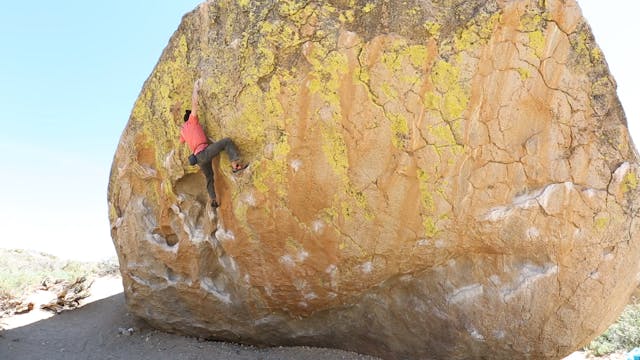Climbing Movement: 1. The Process of Movement
Climbing Movement
•
2m 44s
The process of movement aims to describe and analyze the pattern your body follows to efficiently attain the next hold, using gravity in our favor.
The process of movement also consists of ways to generate momentum with your body (as seen in the video), keeping in mind your arms will always fail you before your core and leg muscles tire out.
The most common bad habit with climbing movement is initiating moves with our upper body. This often includes incorrectly pulling or bending at the elbow. This inefficient technique makes you reliant on your upper body to do the holding on, as well as for moving to the next handhold. Making climbing moves with just your arms is usually incorrect and tiring.
Remember, our legs have some of the largest muscles. They are the heaviest, but also the strongest muscles. Try to use your leg muscles, and not just carry them up the wall with your arms.
Let’s qualify this point by saying there isn't anything wrong with pulling. That stated, ideally you forgo initiating movement with arm muscles, seeing how they become fatigued way faster than core and leg muscles.
Let's break down the process of movement, starting with the all-important Posturing position:
Imagine yourself on the wall. Most moves begin with an adjustment of your foot. This implies you will look down to find the foothold(s). It also means your scapula (shoulder blade) at that moment is disengaged. Your hips are also away from the wall, and your heels are lower than the point of contact (most often your toes).
Step 1: Set your scapula, or pull your chest up and into the wall at your shoulders without bending at the elbow.
Step 2: Arch your back and shift your center of gravity over the weight bearing platform (i.e. foothold).
Step 3: After you've shifted over your foothold and arched your back into the wall, you then use the power in your legs and feet, and push with these larger muscles. Make sure you remember to breathe, and continue engaging your core muscles.
Step 4: Pull or bend your arm at the elbow, if needed.
If you begin to follow the process of movement, you find there are a ton of moves across all grades and disciplines where you can forgo pulling or relying on your upper body to attain the next move. If you initiate moves by pulling, you fail to make the best use of footholds and your arms most likely become too pumped. The process of movement allows you to transition, save energy, and keep climbing!
We hope you found this video helpful. Feel free to comment below with questions or thoughts!
Please remember, climbing is inherently dangerous. Climb at your own risk.
Up Next in Climbing Movement
-
Climbing Movement: 2. Direction of Pull
Most climbing holds have an ideal angle from which to pull. This indicates the direction of pull. Knowing how your hand should grab any hold is important in “planning your route”. This helps you determine your hand and foot “sequence”.
The direction of pull helps you understand how to make be... -
Climbing Movement: 3. Hand Hold Orien...
There are four basic types of hand-hold orientations found in rock climbing. This video does not describe the types of holds, such as a crimper or sloper. Instead, we are talking about hand-hold orientation.
The four types of hand-hold orientations:
1. Horizontal hold - With this type of ...
-
Climbing Movement: 4. Open Hand vs. I...
Let’s review the difference between Open Hand hand holds, and In-Cut hand holds. Think of open hand and in-cut as two different families of holds.
Open Hand - When your hand becomes molded to the rock, without an in-cut feature that allows you to pull on (or away from) the wall. Climbing on o...


